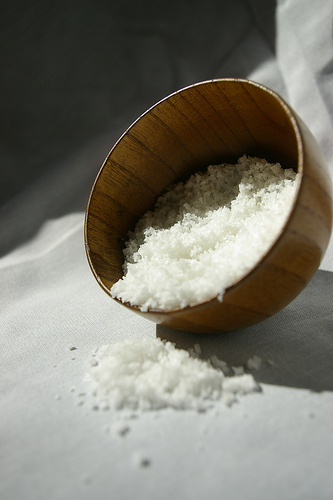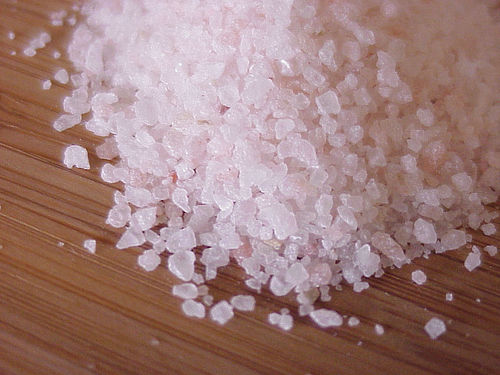Fancy salts and how to cook with them

If you have never ventured farther than the tried and true classic blue cardboard canister of Morton's table salt, you are doing yourself (and your food) a real disservice. You don't have to shop at a fancy overpriced salt bar to find some much better alternatives out there. It may seem ridiculous that the kind of salt you use can make a difference, but it's true. In fact, I would go so far as to say that the salt can make or break a dish.

Image courtesy Flickr/vmiramontes
1. Regular Old Table Salt
Cheap and abundant in modern society, plain old table salt is sodium chloride which has been mined from caves. Table salt typically has been iodized by adding potassium iodide, sodium iodide, or sodium iodate. Other salts do not contain iodine, which has been added for health reasons. But rest assured, there's plenty of iodized salt in everything else you eat. You'll be fine.
Table salt has a metallic, chemical taste that becomes off-putting once your palate adapts to better forms of salt.

Image courtesy Flickr/stbites.com
2. Kosher Salt
Kosher salt is a somewhat improvement over table salt, because of the grain size. It's the same salt, but it is a much bigger grain. This makes it easier to control the volume of salt you're using, and makes it less likely you will over-salt what you're cooking. Kosher salt also tastes a little bit better because most varieties are not iodized.
(Incidentally, kosher salt gets its name because it is used in the process of making meat kosher. It is sprinkled atop cut meat and used to draw out the surface blood.)

3. Sea Salt
This is the first "fancy salt" every beginner should try. Sea salt is now readily available in most grocery stores. I have a little single-use sea salt grinder made by Morton's which I bought on the spice aisle at Safeway.
Sea salt is sodium chloride which has been evaporated out of seawater. It typically has not been iodized, but it will contain other trace elements and minerals from the original seawater. The difference in taste between sea salt and regular table salt is striking.

Image courtesy Flickr/Koocheekoo
4. Hawaiian Pink and French Gray Sea Salts
Pink sea salt and gray sea salt are both popular among gourmets. These salts are colored by the clay or minerals which are left behind after that particular batch of seawater has been evaporated.
Hawaiian Pink sea salt is colored with "alaea," a volcanic red clay which is often given additional color with iron oxide. French Gray sea salt gets its color from the gray clay bottoms of the salt bays where it is gathered on the French Atlantic shore.
Both of these salts offer a fun and unexpected addition to the dinner table. Their tastes are subtle, which means that they should be used as a finishing touch at the table, rather than thrown into the dish as you cook it.

Image courtesy Flickr/fritish
5. Fleur de Sel
Speaking of French gray salt, Fleur de Sel is harvested from the same locations as French gray. Fleur de Sel is one of the most expensive salts on the market, because it is so labor-intensive to collect. It's basically just very large crystals of French gray sea salt.
It might seem like nothing particularly special compared to ordinary sea salt, but Fleur de Sel is revered in French culture. Fleur de Sel harvesting began in France around the time the Roman Empire collapsed.
This too is best used as a finishing touch, or as a flourish atop caramels, chocolates, or other fancy desserts.

Image courtesy Flickr/joyosity
6. Smoked Sea Salt
A lot of small local producers are getting into the business of making smoked salt which is, as you might have guessed, salt which has been run through a smokehouse to produce a strong smoky flavor.
I used to think of smoked sea salt as an interesting curiosity. Until last summer, when I tried it fresh ground and sprinkled over buttered corn on the cob. It pretty much blew my mind. It's certainly not an "everyday salt," but given the right application it can be amazing.

Image courtesy Flickr/julajp
7. Himalayan Pink Salt
This salt is hand-mined from the Himalayas, where it is found in veins of red and pink salt crystals due to the iron oxide and other minerals.
Most of the claims regarding Himalayan pink salt are health-related and thoroughly unscientific. Himalayan pink salt is currently popular as a cure-all, which means that from a culinary standpoint, you're probably better off with one of the other alternatives.
Main image courtesy Flickr/Happy Krissy

2 comments